► Ronin celebrates its 25th anniversary
► The car chases that shaped the film industry
► Our take on a classic of the genre
25 years ago today, a film was released that rewrote the car chase rulebook. It featured visceral, metal-crunching chases that put the viewer – and the actors – at the heart of the action. Chases that had a sense of scale and consequence. That film was Ronin. And for many, this writer included, the two chase sequences in Ronin remain the best that have ever been committed to film.
I first saw Ronin the day of my 15th birthday, renting the video from Blockbuster. I wasn’t old enough to see it in the cinema, but the trailer had jumped off the screen and burrowed deep into my brain. It heavily featured the car play and, to a car-obsessed teenager, it looked like the greatest film ever. I couldn’t wait to see it.
I watched the film utterly rapt. I’d seen plenty of car chases before, but none like this. None so tense, none so realistic. And none that featured the original D2-gen Audi S8. Oh, the Audi S8…
Let’s consider how Ronin as a whole holds up. Be warned, there will be spoilers. The film follows a band of international mercenaries who’ve been engaged by an Irish dissident group to steal a case from Russian arms dealers.
There’s ex-KGB computer expert Gregor (Stellan Skarsgaard); probably disgraced former SAS man Spence (Sean Bean); American driver, possibly a failed racer, Larry (Skipp Sudduth); ex-Foreign Legion soldier Vincent (Jean Reno) and apparently former CIA operative Sam (Robert De Niro). Attempting to lead them is Deidre (Natasha McElhone), a member of the dissident group.
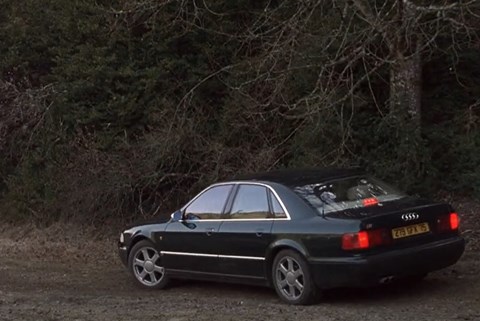 Credit: MGM United Artists
Credit: MGM United Artists
They gather in a Paris warehouse. Sam quickly assumes the role of leader, successfully demanding a lucrative new pay deal. Plans are made, equipment is sourced, a weapons buy goes badly wrong – Spence proves massively out of his depth. He’s sent packing with a pay-off and a warning that I suspect he doesn’t heed.
The group heads to Nice, staging an ambush to seize the mysterious case, only for the duplicitous Gregor to half-inch it. As he attempts to sell the case, the rest of the group track him across France back to Paris. Also on the trail is Seamus (Jonathan Pryce), Deidre’s untrusting boss.
Gregor finds a buyer for the case, but the price is so high the deal concludes with a bullet to his head. Everyone else is on site, though. Seamus gets his hands on the case, shoots Sam but is himself killed by Vincent. Sam reaches out for the case that has caused so much trouble.
Back at the café where they first met, Vincent asks Sam what was in the case. ‘I don’t remember.’
It’s a labyrinthine tale of betrayal and double-crossing, in a world where everyone would sooner kill you than do an honest deal. Yet the genuine friendship that develops between Sam and Vincent leaves them as the last men standing. What was in the case? It really doesn’t matter.
Fun fact: there are three former Bond villains among the cast: Jonathan Pryce (Tomorrow Never Dies), Sean Bean (Goldeneye) and Michael Lonsdale (Moonraker).
Ronin is a genuinely good film, tautly directed by John Frankenheimer to a sparse screenplay co-written by David Mamet, with an atmospheric score by Elia Cmiral that features a deeply cool drum groove. The understated performances ring true, it rolls along at a clip, you can really feel the chill of the French winter during which it was filmed. It’s tense, thrilling and keeps you guessing to the end, even after multiple viewings.
Ronin made surprisingly little impression on release, only just turning a profit, but it has lived long in the hearts of petrolheads the world over because of those car chases.
The subject of cars comes up almost immediately when Larry is asked what he wants. ‘Something very fast – Audi S8, something that can shove a little.’
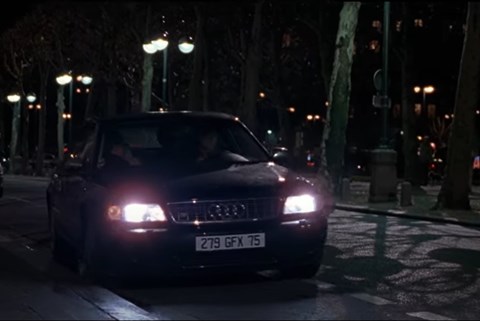 Credit: MGM United Artists
Credit: MGM United Artists
Has there ever been a car as cool, as understatedly menacing, as the D2 Audi S8? It’s deeply handsome, too, especially in the dark green of the Ronin car. The high-performance version of Audi’s all-aluminium A8 luxury saloon, it featured a 4.2-litre V8 and quattro four-wheel-drive in its revolutionary spaceframe chassis.
Early versions built from 1996 had 340hp which could get the S8 from 0-62mph in 5.6 seconds before hitting a limited top speed of 155mph – 175mph was achievable downhill while the driver relaxed in the lap of luxury. UK cars had an automatic gearbox, European models had a six-speed manual as standard.
CAR drives a Ronin-spec Audi S8
In period, the S8 was criticised for its finesse-free handling and hard ride but was praised for its huge speed and rock-solid stability – exactly what a getaway driver needs from his wheels.
The S8 is first put to use escaping the botched weapons deal, hammering along side streets and sliding through junctions. It’s fast and controlled but spectacular with it. Skipp Sudduth was an experienced stunt driver and did as much driving as possible, Frankenheimer telling him he didn’t want to ever see the brake lights.
That first sequence alone lit a fire under me that hasn’t gone out. I yearn to own a D2 S8 and I’ve come close on several occasions. They remain ridiculously cheap in the UK but running costs are fearsome and there are cripplingly expensive issues with the auto ‘box. For now, sense must prevail over teenage dreams but one day I’ll track down a Euro-spec manual.
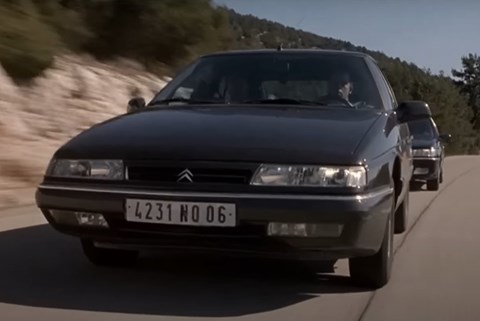 Credit: MGM United Artists
Credit: MGM United Artists
Things get serious when the action moves to the Riviera. The group intercept the case in La Turbie’s market square, its minders driving Peugeot 605s while the case and its carrier are in a Citroen XM. The Citroen and a couple of Peugeots evade the ambush, pursued by Sam and Vincent in a Mercedes 450 SEL 6.9. Vincent performs a perfect J-turn into a 90-right to take up the chase. In the making-of documentary, Reno says he did as much driving as he was allowed to.
Out in the countryside, the French cars pass Larry in the Audi. He immediately takes out a 605, then tussles with the Citroen, trading paintwork and dislodging light clusters. The chase diverts off-road, the cars leaping over a huge berm before skittering into the back streets of Nice. A market is destroyed, pedestrians dive for cover. The sequence crunches to a halt on the harbourfront as the XM and S8 crash into a café.
At no point do you doubt that any of what you’re seeing is real. The cars are being pushed to the absolute limit in corners and blast down narrow alleys at 50mph-plus. The speed and jeopardy jump off the screen. Only when some actual acting was needed were stunt drivers employed to pilot specially built replica cars from their boots.
Frankenheimer invented the visual language of on-screen car play with the 1966 film Grand Prix. He wanted to put the viewer as close to the action as possible and give them a driver’s eye view. The techniques he developed have been used in every car chase made since.
Le Mans class winner and Remy Julienne protégé Jean-Claude Lagniez led a team of 300 stunt drivers, all of them professional racers. They included ex-F1 driver Jean-Pierre Jarier and ultra-experienced journeymen Guy Chasseuil and Michel Neugarten. Lagniez knew drivers of their quality could be trusted to hit their marks consistently and safely and, most importantly, wouldn’t be fazed by the speeds involved.
The action moves to Arles, the group travelling by top-spec Renault Safrane, while Gregor finds an XJ Jeep Cherokee. Another shoot-out follows and Larry is brutally murdered, leaving Vincent to carjack a base-model Mk.3 Golf to take a gravely injured Sam to safety.
Next, we’re in Paris where we find Seamus, Deidre and Gregor together, the latter two very much against their will. Somewhere along the line, they’ve got hold of an E34 BMW 5 Series of contested designation. Meanwhile, Sam and Vincent are in a Peugeot 406.
Our heroes catch up to their quarry outside a post office. Deidre, at the wheel of the BMW, takes off, while Sam pursues in the Peugeot, both picking up their compatriots as they go. So begins the centrepiece chase of the film, the one that stands head and shoulders above all others.
The action kicks up a notch over the Nice sequence, the cars being driven well beyond the limit – as they had to be. On the wide boulevards and motorways of Paris, the speeds needed to be a lot higher to give a real impression of speed. 100mph was regularly topped, rumour has it 120mph was reached in places.
The chase tours Paris, leaving chaos in its wake. Innocent motorists have massive crashes trying to avoid it, people get injured and even killed. Things get desperate as the cars dive into a tunnel on the wrong side of the road. Deidre looks absolutely terrified as she dodges on-coming traffic; Sam isn’t happy about it, either.
On a motorway, Seamus and Vincent start shooting at each other. As the cars blow through roadworks, a perfectly aimed (or incredibly lucky) shot punctures the BMW’s back tyre, pitching it into a roll. It slides off the end of the unfinished road and crashes to the ground below as the Peugeot slews to a stop. Roadworkers rescue the injured occupants just as the BMW blows up.
My 15-year-old jaw still on the floor, I immediately hit rewind to watch the chase again. Four times.
Filming the chase took a month. Multiple 5 Series and Peugeots were used. For interior shots, the front end of an example of each car was cut off so it could be towed behind a Mercedes 500E that also carried the camera rig. Incidentally, I believe the Mercs had previously been used as the villains’ cars in Luc Besson’s film Taxi, which had been made the previous year and also featured Jarier among the driving team. Point-of-view cameras were carried on the front of various Porsche 911s.
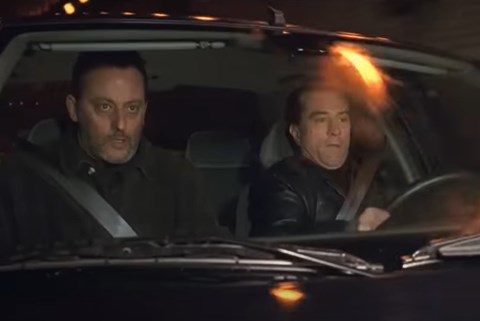 Credit: MGM United Artists
Credit: MGM United Artists
The production also used right-hand-drive cars with left-hand-drive dashboards spliced in that were used for close-ups of De Niro and McElhone. It was, by all accounts, a terrifying experience, particularly for De Niro who obviously wasn’t used to being driven at 11 tenths by a racing driver he barely knew. But he relaxed once Frankenheimer’s wife tried it.
It’s these kinds of details that set the Paris chase apart. They meant it could be done for real, on location, at full speed. You can practically feel the G-forces as the cars oversteer and handbrake through turns, almost smell the hot engines, burning brakes and frying clutches. The only (rather shonky) CGI is used to turn the BMW’s occupants upside down.
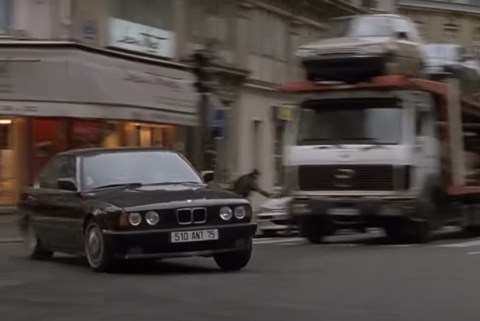 Credit: MGM United Artists
Credit: MGM United Artists
You can level criticisms at the Ronin chases. They’re geographically nonsensical and the continuity is all over the place. Pre- and post-facelift XMs are used in the Nice chase, there are regular A8s mixed in with the S8s, the 406 switches from a four- to a six-cylinder engine. Then there’s that blessed E34. Apparently four were used, at least one which was a very early M5 that’s used for some of the ‘hero’ shots. However, in other shots, it’s clearly not an M5 and one of the Sport pack-equipped 535is or 525is that were also on set.
I disregard anyone complaining the actors look scared in the cars because wouldn’t you be? I don’t care how good a driver you are, driving that hard and fast through a busy city would scare the whatsit out of anyone.
None of that dissuades me from my thesis, though. In Ronin, Frankenheimer and stunt co-ordinator Joe Dunne staged two chases that haven’t been bettered. Some have come close, like the Volga chase in The Bourne Supremacy. But every single one that’s followed has a whiff of unreality about it. And it’s the realism, more than anything else, that’s at the core of Ronin’s enduring appeal.